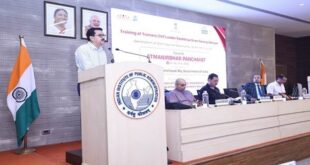Recently, the Union Minister of Health and Family Welfare presided over the 112th Annual Day celebrations of National Centre for Disease Control (NCDC).
Important points:
- The Whole Genome Sequencing (WGS) National Reference Laboratory for Antimicrobial Resistance (AMR) was inaugurated.
- WGS is a comprehensive method for analyzing entire genomes. Genomic information has been instrumental in identifying inherited disorders, characterizing the mutations that drive cancer progression, and tracking disease outbreaks.
- Rapidly dropping sequencing costs and the ability to produce large volumes of data with today’s sequencers make whole-genome sequencing a powerful tool for genomics research.
- AMR is the resistance acquired by any microorganism (bacteria, viruses, fungi, parasite, etc.) against antimicrobial drugs (such as antibiotics, antifungals, antivirals, antimalarials, and anthelmintics) that are used to treat infections.
- The application of WGS for global surveillance can provide information on the early emergence and spread of AMR and further inform timely policy development on AMR control.
Adaptation :
- The National Health Adaptation Plan on Air Pollution and National Health Adaptation Plan on Heat Related Illness were launched under the “National Programme on Climate Change and Human Health (NPCCHH)”.
- The plan suggests setting up of a committee on air pollution and health in the hospital, to preferably involve health officials from the departments of medicine, respiratory,medicine, paediatrics, cardiology, neurology, endocrinology etc, including emergency and nursing department.
- It also highlights the need for preparations for logistics, drugs and equipment that may be required to address such health problems, particularly respiratory and cardiovascular emergencies.
- It also highlights the need for identification of vulnerable areas, selection of air pollution hotspots as per Air Quality Index (AQI) levels, vulnerable population covering people less than five years of age, adolescents, pregnant women and the elderly.
- Under the “National One health Programme for prevention and Control of Zoonoses” IEC materials on 7 priority zoonotic diseases has been created namely:
- Rabies, Scrub Typhus, Brucellosis, Anthrax, Crimean-Congo haemorrhagic fever (CCHF) , Nipah, Kyasanur Forest Disease in India.
Objectives:
- To create awareness among the general population (vulnerable community), health-care providers and Policy makers regarding impacts of climate change on human health.
- To strengthen the capacity of the healthcare system to reduce illnesses/ diseases due to variability in climate.
- To strengthen health preparedness and response by performing situational analysis at national/ state/ district/ below district levels.
- To develop partnerships and create synchrony/ synergy with other missions and ensure that health is adequately represented in the climate change agenda in the country.
- To strengthen research capacity to fill the evidence gap on climate change impact on human health.
National Centre for Disease Control:
- The National Centre for Disease Control (NCDC), formerly National Institute of Communicable Diseases (NICD), had its origin as the Central Malaria Bureau, established at Kasauli (Himachal Pradesh) in 1909.
- NICD was transformed into the NCDC with a larger mandate of controlling emerging and re-emerging diseases in 2009.
- It functions as the nodal agency in the country for disease surveillance facilitating prevention and control of communicable diseases.
- It is also a national level institute for training specialized manpower for public health, laboratory sciences and entomological services and is involved in various applied research activities.
- The Institute is under administrative control of the Director General of Health Services, Ministry of Health and Family Welfare.
- The Institute has its headquarters in Delhi.
- Undertakes investigations of disease outbreaks all over the country.
- Provides referral diagnostic services to individuals, community, medical colleges, research institutions and state health directorates.
- Engaged in generation and dissemination of knowledge in various areas like Epidemiology, Surveillance, and Laboratories etc.
- Applied integrated research in various aspects of communicable as well as some aspects of non-communicable diseases has been one of the prime functions of the Institute.
SOURCE: THE HINDU,THE ECONOMIC TIMES,MINT
 Chinmaya IAS Academy – Current Affairs Chinmaya IAS Academy – Current Affairs
Chinmaya IAS Academy – Current Affairs Chinmaya IAS Academy – Current Affairs



